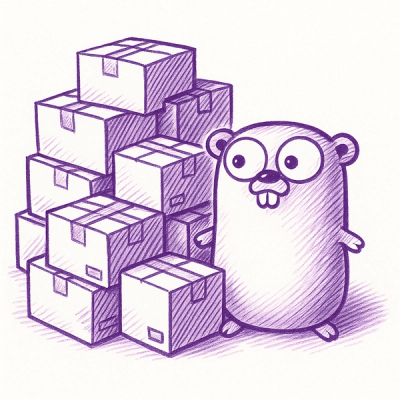
Research
/Security News
Malicious npm Packages Target WhatsApp Developers with Remote Kill Switch
Two npm packages masquerading as WhatsApp developer libraries include a kill switch that deletes all files if the phone number isn’t whitelisted.
Racker is an experimental harness tool for provisioning and launching operating system containers
Racker
.. container::
*Operating system containers for humans and machines.*
- **Documentation**: https://github.com/cicerops/racker
- **Source code**: https://github.com/cicerops/racker
- **PyPI**: https://pypi.org/project/racker/
|
.. image:: https://img.shields.io/badge/systemd-239%20and%20newer-blue.svg :target: https://github.com/systemd/systemd :alt: systemd System and Service Manager
.. image:: https://img.shields.io/pypi/pyversions/racker.svg :target: https://pypi.org/project/racker/ :alt: Python version
.. image:: https://img.shields.io/pypi/v/racker.svg :target: https://pypi.org/project/racker/ :alt: Version
.. image:: https://img.shields.io/pypi/status/racker.svg :target: https://pypi.org/project/racker/ :alt: Maturity status
.. image:: https://github.com/cicerops/racker/workflows/Tests/badge.svg :target: https://github.com/cicerops/racker/actions?workflow=Tests :alt: Test suite status
.. image:: https://codecov.io/gh/cicerops/racker/branch/main/graph/badge.svg :target: https://codecov.io/gh/cicerops/racker :alt: Test suite code coverage
.. image:: https://img.shields.io/pypi/l/racker.svg :target: https://pypi.org/project/racker/ :alt: License
.. image:: https://pepy.tech/badge/racker/month :target: https://pepy.tech/project/racker :alt: PyPI downloads / month
About
Racker is an experimental harness tool for provisioning and launching
containers, with a focus on operating system containers <OS containers_>_.
By a "harness tool", we mean a combination of image bakery and payload launcher.
mkosi_ and Packer, as well OCI-compliant container images <OCI Image Format_>. Container images can be acquired from both vendor-
specific and standardized distribution channels like OCI-compliant image registries <OCI Distribution Specification_>_.A lightweight wrapper around systemd-nspawn to provide and launch
container environments for/with systemd.
A lightweight wrapper around vagrant to provide convenient access to all
things needing a full VM, like running Windows on Linux or macOS.
A tribute to the authors and contributors of GNU, Linux, systemd, Python, VirtualBox, Vagrant, Docker, Windows, Windows Docker Machine and countless others.
Launch interactive command prompts or invoke programs non-interactively within a isolated and volatile Linux and Windows environments.
Build upon the runtime harness framework to build solutions for running and testing software packages in different environments, mostly run headless and non-interactively.
Racker has two different subsystems / runner backends, one for Linux and another one for Windows.
systemd_ and
systemd-nspawn_. Provisioning of additional software is performed using the
native package manager of the corresponding Linux distribution.On the host side, Racker can run on Linux, macOS, and Windows. On the container side, the following list of operating systems has been verified to work well.
Linux .....
The aims of Racker are very similar to Docker, Podman, Distrobox_ and
Toolbox_. However, there are also some differences.
Most people running Linux probably want to use Podman_ these days. For more
background, enjoy reading Container wars_ and Container Tools Guide_.
systemd-nspawn_ and Vagrant_ instead of
Docker_ or Podman_.OS containers_
aka. OS-level virtualization, using systemd as init process.See also Comparison with similar tools - more details_.
systemd-nspawn``systemd-nspawn`` may be used to run a command or OS in a light-weight
namespace container. In many ways it is similar to ``chroot``, but more
powerful since it fully virtualizes the file system hierarchy, as well as
the process tree, the various IPC subsystems and the host and domain name.
It is primarily intended for use in development, experimenting, debugging,
instrumentation, testing and building of software.
It can easily be used to start containers capable of booting up a complete
and unmodified Linux distribution inside as normal system services.
For learning more details about systemd-nspawn, we strongly recommend to
read the more extensive systemd-nspawn in a nutshell_.
Setup
Install prerequisites::
apt-get update
apt-get install --yes systemd-container skopeo umoci python3-pip python3-venv
Install Racker::
python3 -m venv .venv
source .venv/bin/activate
pip install racker --upgrade
To install the latest development version, use this command instead::
pip install git+https://github.com/cicerops/racker --upgrade
.. note::
If you are not running Linux on your workstation, the documentation about
the `Racker sandbox installation`_ outlines how to run this program within
a virtual machine using Vagrant.
Usage
The racker program aims to resemble the semantics of Docker by providing a
command line interface compatible with the docker command.
::
# Invoke the vanilla Docker `hello-world` image.
# FIXME: Does not work yet.
# racker run -it --rm hello-world /hello
# racker run -it --rm quay.io/podman/hello
# Acquire rootfs images.
racker pull debian:bullseye-slim
racker pull fedora:37
# Launch an interactive shell.
racker run -it --rm debian:bullseye-slim bash
racker run -it --rm fedora:37 bash
racker run -it --rm docker://registry.access.redhat.com/ubi8/ubi-minimal /bin/bash
racker run -it --rm docker://quay.io/centos/centos:stream9 bash
# Launch a single command.
racker run -it --rm debian:11-slim hostnamectl
racker run -it --rm opensuse/tumbleweed hostnamectl
racker run -it --rm ubuntu:jammy /bin/cat /etc/os-release
racker run -it --rm registry.suse.com/suse/sle15 /bin/cat /etc/os-release
racker run -it --rm registry.suse.com/bci/bci-base:15.4 /bin/cat /etc/os-release
racker run -it --rm docker://ghcr.io/jpmens/mqttwarn-standard /usr/bin/hostnamectl
# Verbose mode.
racker --verbose run -it --rm fedora:37 hostnamectl
# Use stdin and stdout, with timing.
time echo "hello world" | racker run -it --rm fedora:37 cat /dev/stdin > hello
cat hello
The idea behind postroj is to provide an entrypoint to a command line
interface implementing actions that don't fit into racker, mostly having a
more high-level character.
Currently, postroj pkgprobe implements a flavor of full system
integration/acceptance testing in order to test the soundness of actual
installed binary distribution packages, in the spirit of autopkgtest_.
To do so, it implements the concept of curated operating system images, whose labels have a different layout than labels of Docker filesystem images.
Getting started::
# List available images.
postroj list-images
# Acquire images for curated operating systems.
postroj pull debian-bullseye
postroj pull fedora-37
# Acquire rootfs images for all available distributions.
postroj pull --all
# Run a self test procedure, invoking `hostnamectl` on all containers.
postroj selftest hostnamectl
Package testing::
# Run a self test procedure, invoking example probes on all containers.
postroj selftest pkgprobe
# Run two basic probes on different operating systems.
postroj pkgprobe --image=debian-bullseye --check-unit=systemd-journald
postroj pkgprobe --image=fedora-37 --check-unit=systemd-journald
postroj pkgprobe --image=archlinux-20220501 --check-unit=systemd-journald
# Run probes that need to install a 3rd party package beforehand.
postroj pkgprobe \
--image=debian-stretch \
--package=http://ftp.debian.org/debian/pool/main/w/webfs/webfs_1.21+ds1-12_amd64.deb \
--check-unit=webfs \
--check-network=http://localhost:8000
postroj pkgprobe \
--image=debian-bullseye \
--package=https://dl.grafana.com/oss/release/grafana_8.5.1_amd64.deb \
--check-unit=grafana-server \
--check-network=http://localhost:3000
postroj pkgprobe \
--image=centos-8 \
--package=https://dl.grafana.com/oss/release/grafana-8.5.1-1.x86_64.rpm \
--check-unit=grafana-server \
--check-network=http://localhost:3000
Performance
A SuT which just uses a dummy probe /bin/systemctl is-active systemd-journald
on Debian 10 "buster" cycles quite fast, essentially demonstrating that the
overhead of environment setup/teardown is insignificant.
::
time postroj pkgprobe --image=debian-buster --check-unit=systemd-journald
real 0m0.589s
user 0m0.161s
sys 0m0.065s
On a cold system, where the filesystem image would need to be acquired before spawning the container, it's still fast enough::
time postroj pkgprobe --image=debian-bookworm --check-unit=systemd-journald
real 0m22.582s
user 0m8.572s
sys 0m3.136s
Questions and answers
| Q: How does it work?
| A: Directly quoting the machinectl_ documentation here:
Note that systemd-run_ with its --machine= switch may be used in place of the
machinectl shell command, and allows non-interactive operation, more detailed and
low-level configuration of the invoked unit, as well as access to runtime and exit
code/status information of the invoked shell process.
In particular, use systemd-run's --wait switch to propagate exit status information
of the invoked process. Use systemd-run's --pty switch for acquiring an interactive
shell, similar to machinectl shell. In general, systemd-run is preferable for
scripting purposes.
| Q: How does it work, really? | A: Roughly speaking...
skopeo_ and umoci_ are used to acquire root filesystem images from Docker image registries.systemd-nspawn_ is used to run commands on root filesystems for provisioning them.systemd-nspawn --boot.systemd-run_ is used to interact with running containers.machinectl_ is used to terminate containers.| Q: How is this project related with Docker?
| A: The runtime is completely independent of Docker, it is solely based on
systemd-nspawn containers instead. However, root filesystem images can be
pulled from Docker image registries in the spirit of machinectl pull-dkr_.
Other than this, the racker command aims to be a drop-in replacement for
its corresponding docker counterpart.
| Q: Do I need to have Docker installed on my machine? | A: No, Racker works without Docker.
| Q: How are machine names assigned?
| A: Machine names for spawned containers are automatically assigned.
The name will be assembled from the distribution's fullname attribute,
prefixed with postroj-.
Examples: postroj-debian-buster, postroj-centos-8.
| Q: Does the program need root privileges?
| A: Yes, the program currently must be invoked with root or corresponding
sudo privileges. However, it would be sweet to enable unprivileged
operations soon. systemd-nspawn should be able to do it, using
--private-users or --user?
| Q: Where does the program store its data?
| A: Data is stored at /var/lib/postroj.
In this manner, it completely gets out of the way of any other images, for
example located at /var/lib/machines. Thus, any images created or managed
by Racker will not be listed by machinectl list-images.
| A: The download cache is located at /var/cache/postroj/downloads.
| Q: Where are the filesystem images stored?
| A: Activated filesystem images are located at /var/lib/postroj/images.
| Q: How large are curated filesystem images? | A: The preference for curated filesystem images is to use their corresponding "slim" variants where possible, aiming to only use artefacts with download sizes < 100 MB.
| Q: Are container disks ephemeral? | A: Yes, by default, all container images will be ephemeral, i.e. all changes to them are volatile.
Troubleshooting
It's always the cable. ;]
/etc/resolv.conf.
When in doubt, please add nameserver 9.9.9.9 as the first entry... _autopkgtest: https://www.freedesktop.org/wiki/Software/systemd/autopkgtest/ .. _Chocolatey: https://chocolatey.org/ .. _Comparison with similar tools - more details: https://github.com/cicerops/racker/blob/main/doc/comparison.rst .. _Container Tools Guide: https://github.com/containers/buildah/tree/main/docs/containertools .. _Container wars: https://github.com/cicerops/racker/blob/main/doc/research/container-wars.rst .. _Distrobox: https://github.com/89luca89/distrobox .. _Docker: https://github.com/docker/ .. _machinectl: https://www.freedesktop.org/software/systemd/man/machinectl.html .. _machinectl pull-dkr: https://github.com/cicerops/racker/blob/main/doc/research/machinectl-pull-dkr.rst .. _nerdctl: https://github.com/containerd/nerdctl .. _Microsoft Container Registry: https://mcr.microsoft.com/ .. _mkosi: https://github.com/systemd/mkosi .. _OCI Distribution Specification: https://github.com/opencontainers/distribution-spec .. _OCI Image Format: https://github.com/opencontainers/image-spec .. _OS containers: http://0pointer.net/blog/systemd-for-administrators-part-xxi.html .. _OS-level virtualization: https://wiki.debian.org/SystemVirtualization#OS-level_virtualization .. _Packer: https://www.packer.io/ .. _Podman: https://podman.io/ .. _Racker sandbox installation: https://github.com/cicerops/racker/blob/main/doc/sandbox.rst .. _skopeo: https://github.com/containers/skopeo .. _systemd: https://www.freedesktop.org/wiki/Software/systemd/ .. _systemd-nspawn: https://www.freedesktop.org/software/systemd/man/systemd-nspawn.html .. _systemd-nspawn in a nutshell: https://github.com/cicerops/racker/blob/main/doc/systemd-nspawn.rst .. _systemd-run: https://www.freedesktop.org/software/systemd/man/systemd-run.html .. _Toolbox: https://containertoolbx.org/ .. _umoci: https://github.com/opencontainers/umoci .. _Vagrant: https://www.vagrantup.com/ .. _Vagrant Cloud: https://app.vagrantup.com/ .. _Windows Docker Machine: https://github.com/StefanScherer/windows-docker-machine
FAQs
Racker is an experimental harness tool for provisioning and launching operating system containers
We found that racker demonstrated a healthy version release cadence and project activity because the last version was released less than a year ago. It has 1 open source maintainer collaborating on the project.
Did you know?

Socket for GitHub automatically highlights issues in each pull request and monitors the health of all your open source dependencies. Discover the contents of your packages and block harmful activity before you install or update your dependencies.

Research
/Security News
Two npm packages masquerading as WhatsApp developer libraries include a kill switch that deletes all files if the phone number isn’t whitelisted.

Research
/Security News
Socket uncovered 11 malicious Go packages using obfuscated loaders to fetch and execute second-stage payloads via C2 domains.

Security News
TC39 advances 11 JavaScript proposals, with two moving to Stage 4, bringing better math, binary APIs, and more features one step closer to the ECMAScript spec.